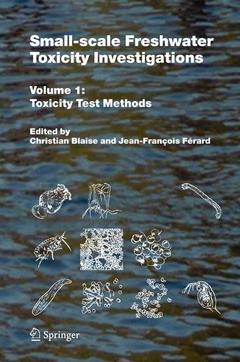Small-scale Freshwater Toxicity Investigations, Softcover reprint of hardcover 1st ed. 2005 Volume 1 - Toxicity Test Methods
Coordonnateurs : Blaise Christian, Férard Jean-François

Christian Blaise, D.Sc., is a senior research scientist at the Saint-Lawrence Centre, Environment Canada, Québec Region, where he heads the Aquatic Toxicology Unit (ATU), River Ecosystems Research Section. He also holds an adjunct professor status at UQAR (Université du Québec à Rimouski) where he contributes to teaching and (co)directs graduate students in the field of ecotoxicology. ATU strives to develop, validate, standardize, modernize (and promote the commercialization of) bioanalytical and biomarker techniques, making use of new instrumental technologies whenever possible, in order to determine the potential (geno)toxicity of chemicals and various types of environmental matrices (e.g., effluents, sediments, pore/surface waters). ATU research output provides practical tools and approaches which facilitate decision-making for environmental management of aquatic ecosystems such as the Saint-Lawrence River. ATU also provides (inter)national technology transfer to interested professionals and agencies and promotes graduate student training by co-directing applied research projects with university collaborators.
Dr. Blaise obtained university diplomas from the U. of Montréal (B.A., 1967: biology and chemistry), U. of Ottawa (B.Sc., 1970: cell biology; M.Sc., 1973: environmental microbiology) and U. of Metz (D.Sc., 1984: ecotoxicology). He is a member of the editorial board for two scientific journals (Environmental Toxicology; Ecotoxicology and Environmental Safety) and holds membership in both the biologists’ (Association des Biologistes du Québec) and microbiologists’ (Association des Microbiologistes du Québec) associations of the province of Québec. He regularly attends and makes presentations during major venues held in the field of ecotoxicology (SETAC: Society of Environmental Toxicology and Chemistry; SECOTOX: Society of Ecotoxicology and Environmental Safety; ATW-Canada: Aquatic Toxicity Workshop-Canada;ISTA: Internationa
Date de parution : 11-2010
Ouvrage de 552 p.
16x24 cm
Date de parution : 09-2005
Ouvrage de 552 p.
15.6x23.2 cm
